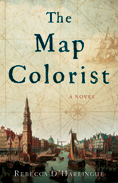
 |
This unique work of historical fiction takes readers to seventeenth-century Amsterdam, where they meet Anneke, a young girl who, along with her brother Lucas, learns the art of map coloring. Anneke learns map coloring from her mother, and soon, her skill surpasses her mother’s. At its core, however, the book provides readers with a careful examination of the historical role of education for women and how historical-artistic and scientific endeavors performed by women were frequently stolen by or wrongly attributed to men.
Throughout the novel, Anneke’s mother, Lysbeth, is a trailblazer in her own right. She is the one who makes sure the children achieve a high standard in the world of map coloring. At times, however, Lysbeth’s snippets of dialogue are clues to the oppression experienced by women during her time period. For example, there is a significant scene in the novel in which Lysbeth is critiquing her children’s map coloring. When she observes the differentiations in their work compared to the original, she states, “We will begin again, children. Yours must look the same as mine. There is a required uniformity to this work.” Lysbeth’s comment about “required uniformity” is a key moment because it also alludes to the “required uniformity” expected by seventeenth-century Amsterdam society. During this time, one’s financial status determined their place within society. Artistic production happened at an increased rate, and scientific development and discoveries flourished. However, despite these progressive elements in society, women were still expected to be more or less confined to the house in order to raise children and maintain the household.
Anneke, from childhood, mirrors her mother’s progressive and innovative ideals. As a child, she questions if, as a map colorist, she will ever be able to use her own ideas. As she grows, Anneke takes the initiative to recreate her father’s African journey—an act that ultimately leads Anneke into the throes of a huge scandal that unravels her and her family’s life. Nonetheless, she eventually finds herself admitted to the Guild of St. Luke as a colorist. As her “unorthodox” coloring of maps helps build her reputation, the guild “looks the other away.” In this moment, readers see the quiet yet rebellious power Anneke develops and holds despite the guild’s attempts to control nearly every aspect of their members’ works.
This book resonates with other books, such as Pattie McCarthy’s Wifthing and Sarah Mangold’s Her Wilderness Will Be Her Manners, that strive to reclaim the many contributions to the arts, science, and culture made by women during times when they could not be recognized. For readers interested in art history, this book is a must-read because of its focus on a critical period in the art world. Anneke is a determined and inspirational heroine, one who resonates with historical figures like Mary Anning and other notable women. Readers who are looking for a book that celebrates female fortitude and innovation will appreciate her character. This book is a gripping read and one that contributes greatly to the conversation about women’s rights that is ongoing even today.
RECOMMENDED by the US Review
The 2024 Eric Hoffer Book Award Historical Fiction Winner